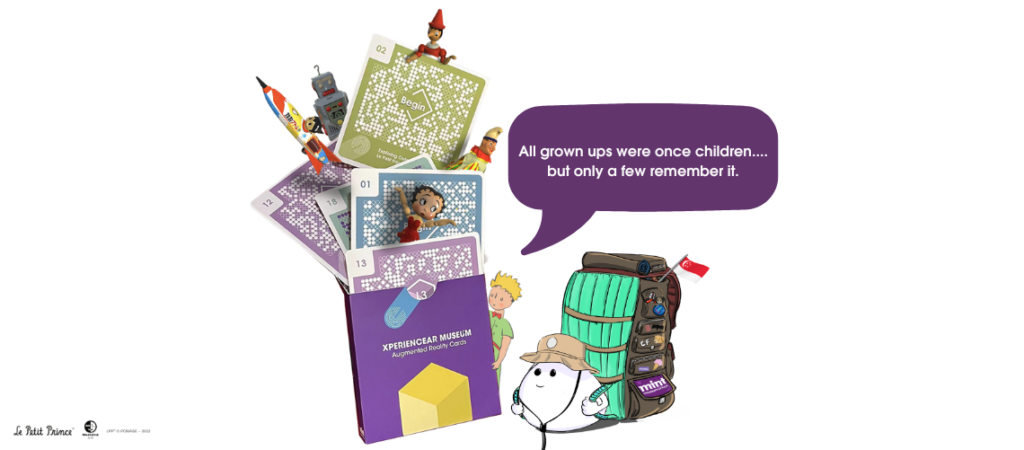
Take a 5-minute walk from Singapore’s City Hall MRT station, and you’ll eventually stumble upon a small museum like no other.
The MINT Museum of Toys is the only space in the country entirely dedicated to showcasing vintage and old-school toys, memorabilia, and collectibles from around the world. And now, we’ve even got our little docent to guide you through our toys!
Our XperienceAR Museum is an Augmented Reality (AR) museum experience featuring the world-famous Le Petit Prince (The Little Prince). Join him as he goes through a “Journey of Rediscovery” through our museum.
While our Virtual Museum lets you see the most popular toys in our collection from the comfort of your home, our AR Museum elevates your real-life museum experience through carefully curated AR touchpoints. Once you’ve finished your AR journey with us, you can bring the AR cards home and enjoy them anytime you wish!
How does it work?

You can only experience the XperienceAR Museum (for the first time at least!) on-site at our museum premises in Singapore.
Once you arrive in our main lobby, use our free Wifi to download the MINT Museum of Toys phone application, available on the Google Play Store and Apple App Store. You can also download the app ahead of your visit.
You’ll receive a goodie bag containing 37 AR cards and a Journey of Rediscovery Map. As you go through our museum, look for the corresponding AR indicators around you. When you see an indicator, scan the matching card from your card deck with the phone app, and an AR touchpoint (complete with voice, sound effects, and even visuals!) will pop up.
This AR experience adds an engaging and interactive dimension to our one-of-a-kind museum in Singapore, with the toys ‘talking to you’ in their own voices. Some of the best-loved vintage toys featured in the AR touchpoints include Popeye, Olive Oyl, and Betty Boop!
Turn up the sound and listen closely to get additional information on the toy or character, and the history and stories behind our collections. Here’s just a handful of the experiences you’ll get to have on this AR tour:
- Meet Buck Rogers and his trusty gang of space explorers (Outerspace, Level 5)
- Have a heart-to-heart chat with Pinocchio (Characters, Level 4)
- Zoom in on the Smallest Doll in the World (Childhood Favourites, Level 3)
- Say hello to a Climbing Monkey from Germany (Collectables, Level 2)
- Learn about the history of Winnie-the-Pooh from the bear himself (Stairwells)
And more!
Visit Singapore’s one and only MINT Museum of Toys today
If you’ve been searching for the best kid-friendly museums to visit in Singapore, the MINT Museum of Toys deserves a spot on your list!
The AR Museum is our latest addition to the museum’s various experiences and modernises a typical museum day out with AR technology. Learn about valuable vintage toys, take a peek at exclusive hidden stories behind old collectibles, and spend quality time together with family or friends in a unique museum unlike any other.
Don’t think that just because we’re a toy museum, we’re exclusively a children’s museum too. That couldn’t be further from the truth! Guests of all ages are welcome to enjoy our collections, special exhibitions, and even activity spaces set up around our various floors. One peek at our collections – featuring some of your childhood favourites – and we promise you’ll feel just like a kid again.
Discover more Augmented Reality apps for kids, or buy your XperienceAR Museum tickets today to begin your journey with The Little Prince by your side.
Everyone’s heard of the Victorian era novelist Charles Dickens, whether because you had to read one of his books for school, or simply because he’s reached a level of fame so many authors can only dream of. His notable works include “Oliver Twist”, “A Christmas Carol”, and “Great Expectations” – novels that have inspired dozens of tributes, homages, and reimaginations over the decades since their publication.
Yet Dickens’ own favourite out of his impressive repertoire was the novel “David Copperfield”. While Copperfield has also been highly popular ever since its publishing, Dickens’ fondness often boiled down to one simple reason: It was the novel that had the most of his own life written into it.
Join us as we discover some of the personal history behind this famous novel.
Who was Charles Dickens?
Charles Dickens was born in Hampshire in February 1812 as the 2nd of his parents’ 8 children. While his early childhood was quite ordinary, things changed in 1824 when his father John was imprisoned for his inability to pay back his mounting debts.
Consequently, Dickens left school at a young age and took on manual labour jobs to support his family through economic hardship. Dickens experienced many frustrations at the struggles faced by working class people during the Victorian era, and channelled these observations into his writing. Many difficult episodes from Dickens’ childhood later made it into his works including Copperfield and “Dombey and Sons”.
He finally managed to attend school for several more years and went on to become a junior clerk, freelance reporter, and political journalist. Dickens began his now-renowned writing career in the 1830s by submitting short stories to periodicals.
What and who was David Copperfield?

Maker: Bradbury & Evans
Year of Make: 1850s
Material: Paper
Country of Origin: United Kingdom
David Copperfield is the eponymous protagonist of the novel “David Copperfield”. The novel was originally serialised between May 1849 to November 1850, and titled “The Personal History, Adventures, Experience and Observation of David Copperfield the Younger of Blunderstone Rookery”.
Dickens had already written over 10 novels before Copperfield and would go on to write many more, but Copperfield remained his favourite until his death in 1870. It is known for being a bildungsroman (a coming-of-age work focusing on a character’s development between youth and adulthood) as well as a critique of social issues in Victorian era society.
Notably, it also has the strongest elements of autobiography and featured incidents lifted right out of Dickens’ life. As he never completed his autobiography and no biography of him was published during his lifetime, Copperfield is one of the closest we’ll ever get to a retelling of Dickens’ life through his own words.
Many characters in Copperfield had real-life analogues including Dickens himself. David struggles through factory work just as Dickens did, and even becomes a reporter and novelist. The characters Edward Murdstone, Wilkins Micawber, and Betsey Trotwood also mirror Dickens’ cruel factory bosses, father, and aunt respectively.
At the same time, there are fictional elements woven into the novel that cause it to be only partly autobiographical. For example, David’s romance with Dora Spenlow mirrors Dickens’ failed romance with Maria Beadnell. However while Beadnell was sent abroad due to her parents’ disapproval of Dickens, Dora dies even after she and David realise their love for each other.
If you’re a Charles Dickens fan, a literature lover, or simply someone curious to peek into the past, you can pay a visit to the MINT Museum of Toys to see a genuine copy of an original David Copperfield!
Head straight to our Level 2 Collectables exhibition to see the book on display as well as other limited-edition and vintage toys, books, magazines, and more from around the world. We’re one museum in Singapore you need to visit if you’re looking for a truly one-of-a-kind experience. Get in touch to find out more or read our blog for more insights into the past through toys and collectibles.
If you recognise the names Flash Gordon, Zorro, Buck Rogers, John Carter of Mars, Conan the Barbarian, or Tarzan, then you have pulp magazines to thank! Sometimes referred to as simply “pulps”, these affordable and popular genre fiction magazines were a major force in the lowbrow literary scene from the late 1890s to late 1950s. They were primarily made in the USA but there were also pulp magazines in the UK and a handful of continental European countries as well.
Named for the inexpensive pulpwood paper they were printed on, pulp magazines succeeded the earlier Victorian-era penny dreadfuls or dime novels. They were considered to be lowbrow or low-quality writing that emphasised the dramatic or fantastical, giving them mixed reputations amongst critics.
Over time the term broadened into its own genre of “pulp fiction” which now includes digest magazines, adventure magazines, and those cheap paperbacks you can grab at any newsstand or airport bookstore. Or you might recognise the term from the 1994 Quentin Tarantino film Pulp Fiction, which pays homage to the gritty over-the-top stories found in pulp fiction magazines of the past.
While pulp magazines aren’t around much anymore, they’ve had a significant impact on the pop culture we do know, recognise, and love. Read on to find out more!
The Early Years and Golden Era

Name: Amazing Stories
Maker: Experimenter Publishing Co
Year of Make: 1928
Material: Paperback
Country of Origin: United States of America
The heyday of pulp magazines lasted between the 1890s to 1940s, with there being an estimated 150 pulp titles in English in 1934 alone. Titles such as “Astounding Stories”, “Planet Stories”, and “Amazing Stories” collected a variety of thrilling stories within their pages, typically from genres which had more room for imagination and creativity. This included science fiction, fantasy, romance, Westerns, adventure, detective, mystery, occult, and even ‘spicy’ erotic pulps.

Name: Amazing Stories
Maker: Experimenter Publishing Co
Year of Make: 1928
Material: Paperback
Country of Origin: United States of America
Despite criticisms about their perceived poor writing quality, pulps were an important form of accessible everyday literature during periods such as the Great Depression and World Wars I and II. Along with radio and the burgeoning film industry, they were the most popular forms of storytelling and entertainment for the average Joe. Many era-defining popular characters first appeared in pulps too – including the science fiction hero Buck Rogers who made his inaugural debut in the copy of Amazing Stories pictured above!
Post-World War II Decline
However, the prominence of pulp fiction entered a sharp decline after World War II. This was in part due to paper shortages that led to rising costs, as well as the increasing popularity of other forms of popular fiction such as comic books. Ironically, the comic book industry had some of its earliest roots in the pulp industry with popular pulp characters like The Phantom Detective, Flash Gordon, and Ka-Zar getting standalone magazine runs or making the jump into comic books.
By the 1960s and 1970s, many genres of pulp fiction disappeared from bookstores and newsstands as they began to be replaced by paperback novels. Only certain genres such as science fiction and mystery manages to survive this era, with some sci fi and mystery pulp magazines still existing today.
Lingering Cultural Impact
While pulp magazines are no longer commonplace, they have had a valuable impact on popular culture.
For one, they’re regarded as predecessors to modern-day superhero comic books – one of the biggest genres in American comics today. Many popular pulp characters such as the ones mentioned above also remain well-known to an international audience, and the science fiction and mystery genres still thrive on the short story anthology format popularised by pulp magazines.
While pulp writing was often derided as fantastical or over-the-top, many renowned and well-respected authors actually wrote for pulps at some point during their careers. Household names including Isaac Asimov, Ray Bradbury, Agatha Christie, Philip K. Dick, Dashiell Hammett, Robert A. Heinlein, H. P. Lovecraft, H. G. Wells, and Tennessee Williams often started out their career writing for pulps before breaking into the big leagues – and it’s no surprise that many of these names are considered mainstays in the very same genres (sci fi and mystery) that dominated pulp magazines too. Other pulp writers moved into publishing or TV writing, helping to shape our pop culture landscape in other ways.
Readers today are also re-embracing pulp fiction, resulting in reprints of classic pulp novels and a rise in modern day pulp fiction stories.
Interested in pulp magazines or the characters that emerged from their pages? Visit the Level 2 Collectables exhibition at the MINT Museum of Toys to see vintage pulp magazines, 80’s vintage toys, and more memorabilia that will take you right back to your childhood!
If you’re looking for a one-of-a-kind experience learning about the history and impact of vintage toys, we’re definitely a museum in Singapore you need to visit. Get in touch for more information on our collections, exhibitions, and pop-up events.
If you’ve ever heard the stories of the tortoise and the hare, the town mouse and the country mouse, the boy who cried wolf, or the ant and the grasshopper – then you have Aesop and his notable collection of Fables to thank. Though their origin dates all the way back to Ancient Greece, they have remained a mainstay in our cultural consciousness ever since.
Come along with us to explore who Aesop was, and what makes his fables so timeless.
Aesop’s Beginnings
Aesop was a Greek slave who lived between 620 to 564 BCE, and was known for his tales that were initially passed down orally before finally being recorded into textual form. There are many conflicting sources about exact happenings in his life, written about by notable names including Aristotle, Herodotus, and Plutarch.
How then did his name survive through the ages, when others did not?
One reason why could be because his oral storytelling revolved around fables, instead of regular stories. Fables are a literary genre that uses anthropomorphised animals, plants, or nature elements to illustrate a moral lesson. This moral lesson is key to the genre and sets it apart from other genres like the fairy tale which may include the same anthropomorphised elements, but with a stronger focus on narrative plot, and no moral lesson.
While Aesop’s Fables might be most well-known collection of fables today, it’s important to note that he was not the only fabulist our there. Other well-known works that included fables are the One Thousand and One Nights (Arabian Nights), Mahabharata, Ramayana, and the stories of Uncle Remus. Modern counterparts that can be seen as fables or have fables-like elements include Animal Farm by George Orwell, and Disney’s 1942 film Bambi.
Aesop’s Fables over Time
Aesop’s oral tales were first compiled by Demetrius of Phalerum in 4th century BCE, but present-day collections are usually based by the version by Babrius (also known as Babrias or Garias) dated to the 2nd century AD.
Some early versions of Aesop’s Fables even included stories from South Asia and the surrounding region, and similar stories appeared in the Jewish Talmud as well. This suggests he was renowned and prolific enough for his stories to continue to be attributed to him long after his death.
Modern collections began to be compiled during the Renaissance, with some changes made to adapt the stories and make them more relatable to a contemporary audience. In zazanilli in Esopo was a 16th century Nahuatl version that incorporated Aztec concepts and rituals to better relate to a Mexican audience, whereas Isopo Monogatari is a 16th century Japanese adaptation of the former that survived even after Westerners were expelled from Japan in the 19th century.
Many fables had anti-authoritarian messages in them that appealed to the learned middle class. At the time, many societies worldwide were greatly hierarchical with the royals, nobility, and clergy at the top – Aesop’s Fables were thus a seemingly benign way to spread powerful messages amongst those who disagreed with this strict social order.
Aesop’s Fables Today
Aesop’s Fables have now been translated into dozens of languages worldwide, with a greater appreciation for their political leanings and interpretations. Translations of Aesop into regional creole in the 19th century, for example, allowed slaves in the Caribbean and South America to better connect with the slavery context of his original tales.
Despite how old Aesop’s work is, the universality of each story, and the progressive ideologies they adopt have given them continued relevance through the times. Short, sweet, yet packing a powerful punch, Aesop’s Fables prove the power of compassion, resistance, and looking out for your fellow man.
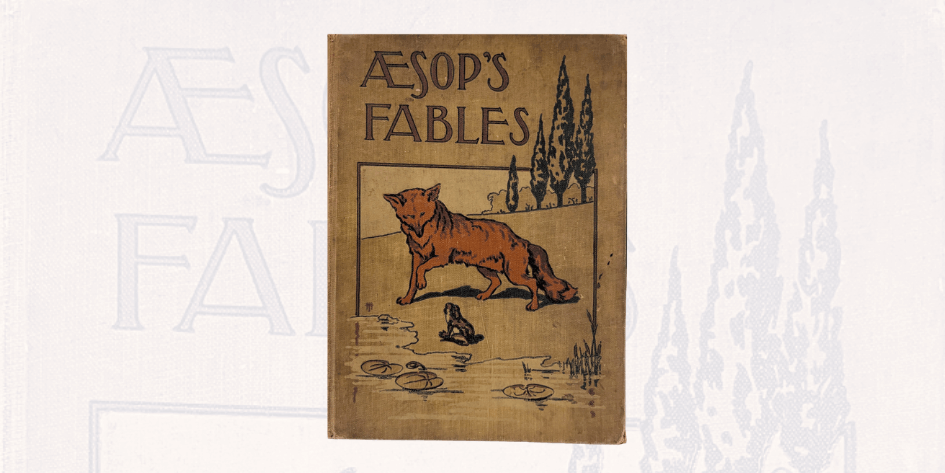
Fables fans, literature enthusiasts, or anyone in love with how history carries on through time, can pay a visit to our toy museum in Singapore and see our copy of Aesop’s Fables dating back to the 1800s! Located at the Level 2 Collectables exhibition, this book is on display alongside dozens of other vintage toys, books, memorabilia, and more.
Get in touch to find out more about our museum. We also offer learning journeys for students in Singapore centered around cool toys and collectibles, and museum tours in Singapore for behind-the-scenes insights at our collections.
Think about East Asian comics today, and some common types might come to mind: Japanese manga, Korean manhwa, and Chinese manhua. However even before all of these entered the popular consciousness in the 20th and 21st century, there was Lian Huan Hua (连环画).
Literally translated as “linked or serial pictures”, Lian Huan Hua consisted of small palm-size books with sequential drawings that were first made popular in the 1880s. Some books included text accompaniment next to the illustrations (similar to captions), whereas others used in-image text or speech bubbles like what we are familiar with in comic books today. They are commonly regarded as an early form of Chinese comics, and a notable precursor to contemporary manhua.
Rise and First Golden Age
The popularity of Lian Huan Hua peaked during the 1880s to 1920s, with the format spreading from Mainland China to Hong Kong. You could often rent a copy from roadside kiosks, which made the books accessible to lower classes who couldn’t afford other forms of entertainment.
Most Lian Huan Hua typically illustrated well-known stories from Chinese myth and folklore, such as The Story of the Three Kingdoms or Journey to the West. Some original publications also used them to depict current events such as popular films, targeting audiences with low literacy who were still able to understand the pictorial narrative even if they couldn’t understand the text.
This latter quality made them highly important to the Chinese Communist Party (CCP) as a form of propaganda directed towards illiterate peasantry. In the 1940s, Lian Huan Hua was widely used to depict Sino-Japanese War and Socialist Realist narratives in order to build up class consciousness and communist solidarity amongst the masses.
Fall and Second Golden Age
By the mid-20th century, Lian Huan Hua began to fall out of popularity in Hong Kong. It was seen as a lower-class or less sophisticated form of popular culture, especially with the Hong Kong film and entertainment scene booming in the 1970s and 80s.
However, Lian Huan Hua continued to be popular in Cultural Revolution China at this time, with a ‘golden era’ in the 1980s and 90s. This was earmarked by a wide proliferation of a variety of narratives and stories, and some titles even had single printing runs of over 1 million copies – a staggering number even by today’s standards. These Chinese comics were used to provide citizens with foreign guides to current events or pop culture, such as illustrating movie scenes or events happening elsewhere in the world.
Unfortunately after the 1990s, Lian Huan Hua finally began to lose popularity for a variety of reasons. This included increased competition from other forms of media, increased censorship over its contents, and the rising dominance of other styles inspired by now-popular Japanese manga and American comic books.
New Resurgence
Today, Lian Huan Hua has largely fallen into obscurity, with the dominant comic forms present in China and Hong Kong today being manhua, manga, and big-name comic franchises such as DC and Marvel.
Regardless, some efforts are currently being made by Chinese artists to highlight and re-showcase Lian Huan Hua to the general public. These efforts often position them as a “grassroots fine art form” and a genre worthy of study, focusing on their cultural relevance during their heyday and their politically charged undertones.

Surviving copies of Lian Huan Hua (especially those pre-dating the 1970s) are now seen as valuable collectibles as well, speaking to the changing political and social mores of a time gone by. Our toy museum in Singapore has a large collection of these Chinese comics proudly displayed at Level 2 Collectables. Old-school memorabilia, toys, and collectibles such as these are a fascinating and valuable way for us to engage with history, and see the past through new and exciting ways. Through seeing remnants of the past, we not only see how things have changed, but better understand what may lie for us now and in the future.See how the past, present, and future come together through our museum tours in Singapore, or get a hands-on experience with our interactive workshops for kids. Peruse our blog for more behind-the-scenes insights into our collections, or get in touch with our team to find out more about what we do.
Ask someone what comes to mind when they hear ‘puppet’, and they’ll probably say Big Bird, Elmo, or any other puppets they’ve seen on the TV. But did you know that puppetry dates back to Ancient Greece, making it one of the oldest forms of storytelling still alive today?
Puppetry can be found in cultures all around the world. Notable regional variants around the Asia-Pacific alone include Japanese bunraku, Indonesian wayang kulit and wayang motekar, and Vietnamese Múa rối nước (water puppets). Ventriloquists, sock puppets, rod puppets, and marionettes are also some of the various puppetry types that have become well-known and utilised by puppeteers and entertainers worldwide, bringing joy to audiences of all ages.
Join us as we dive into the behind-the-scenes of some of the most famous puppets and puppetry styles you might see around you today.
Punch and Judy
Puppetry’s most famous duo can trace their origins back to the 16th-century Italian characters Pulcinella (Punchinello) and Joan. However, they are now most commonly associated with English seaside towns and children’s matinees. Regardless, Punch and Judy are beloved for their back-and-forth banter and increasingly fantastical plots to attack each other. The cast of characters (including mainstays like the Baby, Constable, and Crocodile) adopts slapstick comedy routines and lowbrow humour that rely on pure physical comedy to work, making Punch and Judy shows universally understood without any spoken language or words required.
Kasperle Theatre Finger Puppets
Like Punch and Judy, Kasperle is a puppet character who can trace his lineage back to Pulcinella and his crew. Traditional versions of this German finger puppet routine even seem very similar to the former, focusing on slapstick and physical comedy between Kasperle and characters like Gretel, Seppel, Grandmother, Princess, and Crocodile. Following a reintroduction in the 1970s, Kasperle has experienced a resurgent popularity in Germany. Many Kasperle performances today have satirical elements that poke fun at aspects of German culture and society, reflecting the subversive power of puppetry as an art form.
Chinese Marionettes
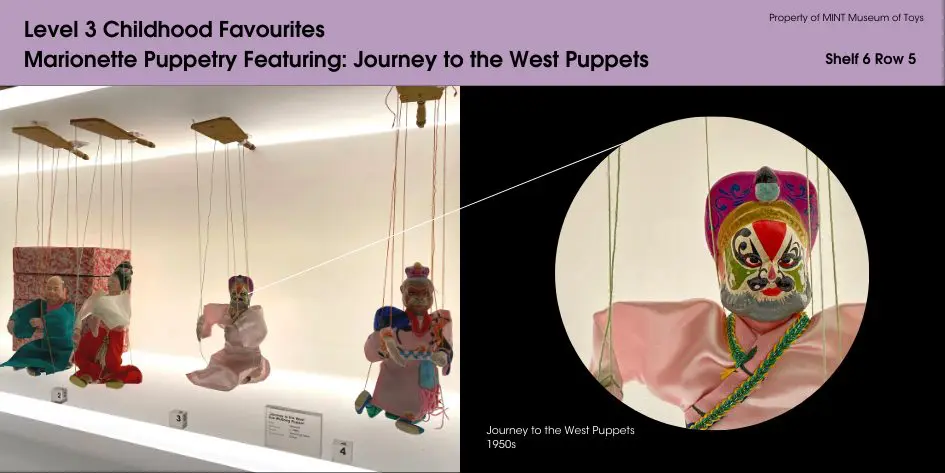
Maker: Unknown
Year of Make: 1950s
Material: Wood and Fabric
Country of Origin: China
The Chinese marionette tradition dates back to the Former or Western Han Dynasty and has persisted through the centuries in some shape or form. The earliest Chinese marionettes can be traced back to the Former or Western Han Dynasty (206 BC-8 CE), with this particular puppetry form enjoying periods of resurgent popularity throughout the centuries that followed. The puppets are traditionally made from wood, silk, and other natural materials in the form of detailed and intricate costumes. Each puppet is attached via strings to a control bar, which the puppeteer controls entirely by hand. Chinese marionette performances typically revolve around religious or folk tales, as seen in these Journey to the West Puppets including a puppet of Sha Wujing. These puppet shows are typically accompanied by live music, mainly through the erhu and pipa – resulting in a uniquely Chinese theatrical performance reflecting many aspects of traditional Chinese culture.
Sesame Street
Of course, a blog on puppets would only be complete with a quick mention of the Sesame Street gang. From the moment Elmo and co. first appeared on TV screens in 1969, they’ve taught countless children about letters, numbers, values such as friendship, compassion, and sharing, and how to deal with challenging real-life situations. The show was first conceptualised as a way to bridge the learning gap between inner-city children, and its development has always been guided by the latest principles in early childhood education. Legendary puppeteer Jim Henson helped develop the original cast of rod puppets for the series, and he even voiced beloved characters such as Ernie and Kermit.
If you’re visiting the MINT Museum of Toys from now till 30 June 2023, pop by the Level 5 Outerspace collection see our latest Guerrilla Event. Dedicated to plush toys of our favourite children’s TV shows since the 1960s, this limited-time pop up features some of the best-loved vintage toys of characters from Sesame Street, Peppa Pig, Care Bears and more. If you’re looking for a family bonding activity to enjoy with kids, here’s your chance to introduce the little ones to your favourite childhood companions!
See a New Side to your Favourite Toys at the MINT Museum of Toys
From Punch and Judy to the Kasperle Theatre to Journey to the West to Elmo, puppets exist around us in all shapes and sizes. Explore the wondrous world of puppetry at Level 3 Childhood Favourites of the MINT Museum of Toys, along with many more best-loved vintage toys and memorabilia. As Singapore’s only museum dedicated to valuable vintage toys and collectables, every floor of our museum promises a one-of-a-kind look at how pop culture has changed throughout the decades.
While our museum is open to visitors of all ages, mums and dads looking to keep the kids entertained can also explore our various family bonding activities at our premises in Singapore’s Civic District. From creative workshops for all ages in Singapore to museum tours guided by none other than the Little Prince to special seasonal exhibitions, there’s something for everyone!
For generations, Popeye the Sailor Man has been a beloved character with a lasting impact on popular culture worldwide. Join us as we trace his rise to popularity over the decades and figure out why he (and his crew) have gathered such a huge fan following.
Comic Origins
Popeye was created by Elzie Crisler Segar in January 1929 for King Features’ Thimble Theatre comic strip and was initially intended to be a side character. Thimble Theatre had already been around for a decade, but Popeye surprisingly gained popularity amongst readers. In fact after Popeye disappeared from the strip for several weeks, he was brought back by popular demand and eventually replaced the original main character Ham Gravy in the 1930s.
The strip was renamed Popeye following Segar’s death and permanently shifted to focusing on Popeye the Sailor Man and his fellow characters we still recognise and love today. The main cast of Popeye’s world includes Popeye himself, his love interest Olive Oyl, his arch-nemesis Bluto (sometimes also known as Brutus), his friend Wimpy, and his adopted child Swee’Pea.
The original comic strips were popular for the fantastical hijinks that Popeye got up to, as well as complex storylines that could last for months while still having a fast-moving and engaging plot. After Segar passed away in 1938, writing for the strip was taken over by various people, most notably Bud Sagendorf from 1959 to 1994.
Shift to Cartoons, TV, and the Big Screen
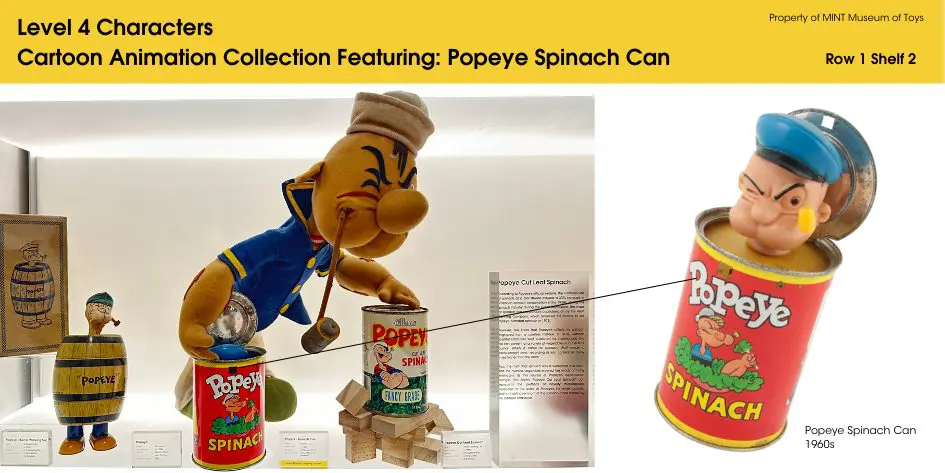
Maker: Mattel, Inc
Year of Make: 1957
Material: Lithographed Tin, Plastic
Country of Origin: United States of America
Following the popularity of the Popeye comics, Paramount greenlit the production of a series of Popeye cartoons. The original run of theatrical cartoons started airing in 1932 and remained part of the Paramount lineup for nearly 25 years until 1957 – catapulting Popeye to being a household name.
It was in the cartoons were the famous connection to spinach first arose. Animators could play around with gravity-defying fight and chase scenes that the comics couldn’t achieve, most of which were propelled by Popeye’s newfound strength thanks to a can of spinach. Spinach-themed Popeye merchandise such as this Popeye Spinach Can began to be produced, reflecting how the unique relationship between Popeye and spinach was a cornerstone of his identity and appeal to the general public.
A newly commissioned Popeye TV cartoon series started airing in 1960 and was syndicated until the 1990s. Several cartoon movies and seasonal specials were also released during this period, cementing Popeye’s presence in the childhood of thousands – or even millions – of kids around the world.
A live-action film starring Robin Williams as Popeye was even released in 1980 on the back of the Popeye craze; although it received poor critical reviews, it did well at the box office and on home video, signalling Popeye’s popularity amongst the masses.
An Enduring Legacy of Spinach and More
Popeye the Sailor Man’s legacy endures to this day, with lingering popularity and recognition even two to three decades after the end of the cartoon’s syndication on TV. You could even say Popeye is one of the few pop culture icons to have affected a completely different field apart from entertainment. After all thanks to the connection between spinach and Popeye’s superhuman strength, many people grew up believing that the iron in spinach was what enabled Popeye to be ‘strong to the finish’. While scientists have since debunked the spinach strength myth, Popeye’s legacy still lives on – making this a powerful testament to the storytelling ability of the cartoons and characters around us, so much so that they can even shape our beliefs and assumptions across generations.
To fully appreciate Popeye’s legacy, fans can visit the MINT Museum of Toys in Singapore and see our Popeye and Thimble Theatre collection at Level 4 Characters. Our limited-time UNBOX Presents: Popeye & Vintage-Inspired Timepieces programme is also showing at the moment, so don’t miss your chance to see it before it’s gone!
While at Level 4, check out the most popular vintage toys of characters from your childhood including Looney Tunes, Snow White and the Seven Dwarfs, and the Flintstones as well as the Jetsons. Whether you were a kid in the 80’s, 90’s, or 00’s, you’re sure to enjoy a wave of nostalgia once you step foot into our museum. We also offer virtual museum tours, workshops for kids, and other exciting activities year-round that showcase the wonderful power of toys.
Hollywood is known for its talented stars and stunning films, as much as its shocking scandals. However, this is nothing particularly new. Go back in time about a hundred years ago, and you’ll find yourself looking at Hollywood that – even by today’s standards – was enough to make anyone gasp.
The early US film industry in the 1920s was highly unregulated and full of outrageous going ons that shocked the general public as they came to light. This included widespread drug use amongst stars, an active party scene away from the cameras, and scandals such as comedian Fatty Arbuckle’s arrest and trial for the alleged rape and murder of actress Virginia Rappe.
Growing public outcry eventually led to the creation of the Hays Code by major Hollywood studios, which was seen as a way to “clean up” the industry and restore public confidence. The code was intended to promote morality and decency in films, and it had a significant impact on the way films were made and consumed in America for several decades.
What was the Hays Code?
The Hays Code was a set of industry guidelines to ensure films were appropriate for general audiences. It was in place between 1934 to 1968, and influenced everything from storylines to wardrobe choices. The code contained many notable inclusions, including bans on depictions of miscegenation (i.e. mixed-race romantic relationships), profanity, and suggestive nudity. Political censorship was also included, leading to anti-Nazi films being derailed due to Nazi leadership in Germany at the time, as they would have been seen as ‘attacking’ another country’s political institutions.
While the Code was entirely self-imposed, enforcement was rigid under Joseph Breen’s leadership at the Production Code Administration. Directors and writers had to find loopholes, often using subtle hints to imply things that couldn’t be shown. Many characters that existed prior to the Code had to be reworked in order to align to the new rules.
One such character was Betty Boop.
Betty Boop: Before and After
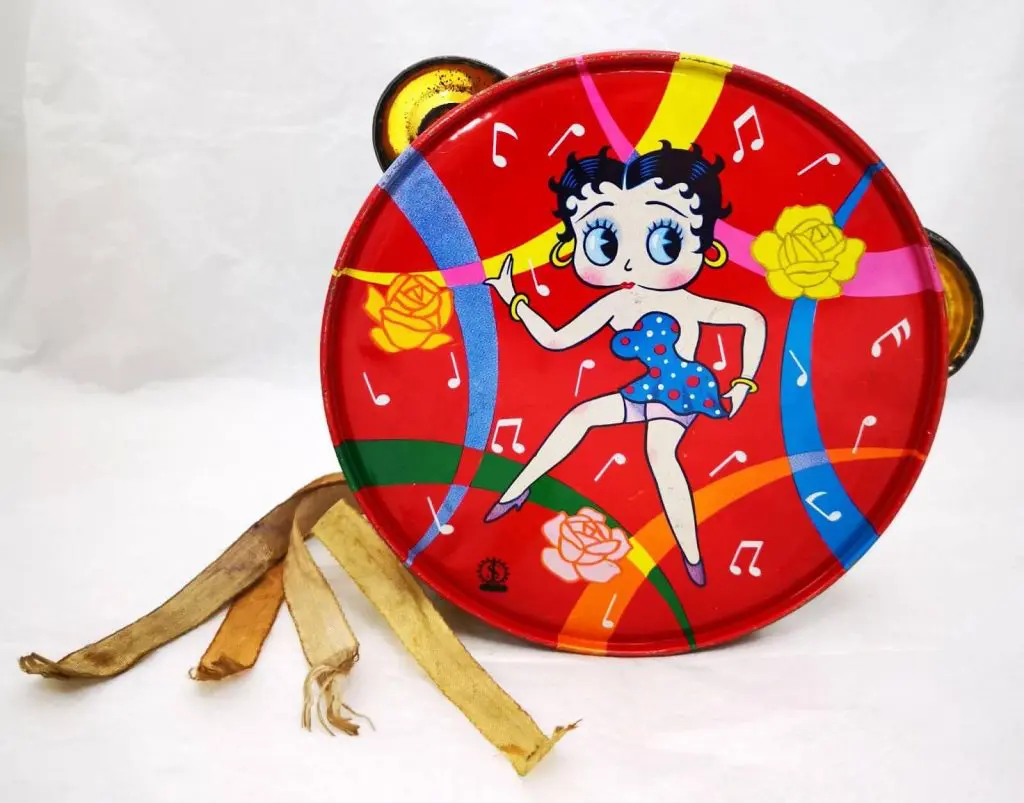
Maker: S.I
Year of Make: 1930s
Country of Origin: Japan
Betty Boop was one of the most iconic cartoon characters of 1930s America, known for her flirtatious personality. Before the Hays Code, Betty was a symbol of female empowerment, showcasing a carefree attitude, challenging gender norms, and redefining femininity through sexual liberation. Her skimpy outfits, high hemlines, and curvy figure (as seen in this Betty Boop Tambourine) made her an instant icon of the times.

Maker: Unknown
Year of Make: 1980s
Country of Origin: United States of America
However, after the introduction of the Code, Betty’s image underwent significant changes as seen in this Betty Boop Alarm Clock. Her strapless dresses were replaced with more modern attire, her garters were hidden, her curves were reduced, and her flirtatious nature was toned down. Betty Boop was transformed from a symbol of female empowerment to a cuter and more innocent character, with her image becoming less risqué and more child-friendly.
The changes made to Betty Boop are just one reflection of the far-reaching and long-lasting impact of the Code on American cinema and pop culture. It not only changed the way films were made but also influenced other forms of media such as television and radio. Though the code was eventually lifted in the 1960s, it’s only been in recent years that Hollywood has begun to portray nuanced discussions of issues surrounding race, sexuality, relationships, abuse, violence, and other sensitive topics.
Then & Now: Toys as a Window into Time
One way we can remember the impact of the Hays Code is through valuable vintage toys such as the Betty Boop merchandise above. If you’re interested in learning more about Betty Boop and other Silent Film toys, come pay a visit to the MINT Museum of Toys in Singapore. Our Level 4 Characters collection features some of the most popular vintage toys and icons from your childhood, including like Looney Tunes, the Flintstones and Jetsons, and Felix the Cat. From now till 30 June 2023, you can also see stuffed toys spanning the 1960s till today at our special limited-edition GUERILLA: Featuring Plush Toys event.
Since time immemorial, humankind has turned to gods, deities, and mythology to help us understand the world we live in. In today’s world, comic book characters can be seen as the modern-day mythic gods that capture our imagination and inspire us with their superhuman feats. They are the embodiment of hope, resilience, and courage in the face of adversity – on top of providing endless hours of entertainment for generations of fans.
Here’s a look at some of the ways our favourite comic book heroes (or even villains or anti-heroes) recreate or subvert traditional narratives and myths.
Superman: An Invulnerable Messiah

Featured Toy: Superman Hand Puppet
Maker: Manopli
Year of Make: 1960s
Country of Origin: Argentina
DC’s Kal-El, also known as Superman, is one of the most iconic superheroes in pop culture today. His in-universe tragic origins as an alien from the doomed planet Krypton combine with his powerful, invulnerable, and near-invincible powers to create the ultimate ‘success story’ to inspire readers worldwide. Some critics have even described him as Christ-like figure, pointing to the messiah-like trope of his arrival on earth.
Yet despite his invulnerability, Superman along with his Justice League allies have faced harrowing cosmic-level threats more than once – and he’s even sacrificed his life in order to save the world (although he was eventually brought back to life). Some would argue this strengthens the comparisons to Christian mythology specifically, while others simply see it as a secular symbol of hope and the triumph of good over evil. Either way, Superman subverts traditional mythic narratives of an omnipotent god, with his struggles and victories reflect humanity’s ponderings on what it really means to be human, and what it means to have a human spirit.
Catwoman: A Modern Take on Ancient Myth
Cats have been linked to femininity and feminine energy for centuries, from the half-cat half-human Ancient Egyptian goddesses Bastet and Sekhmet, to the Chinese goddess Li Shou. The Ancient Greek goddess Artemis and Norse mythology’s Freyja have also been associated with cats, and from more modern narratives we learn of cats as the familiars and companions of witches. So DC’s Catwoman (also known as Selina Kyle) can be seen in this light as yet another modern-day reimagining of this persistent association between women and cats.
As one of Batman’s most famous rivals (and occasional lover), Catwoman treads the line between good and evil. Recent storylines have even developed her role as a vigilante anti-hero, moving away from her origins as a decidedly ‘bad’ cat burglar. Her mythos blurs the line between black-and-white narratives of good and evil, and is no doubt a big reason she’s one of the most popular anti-heroes in the DC universe today.
Flash Gordon: The Everyman’s Odysseus
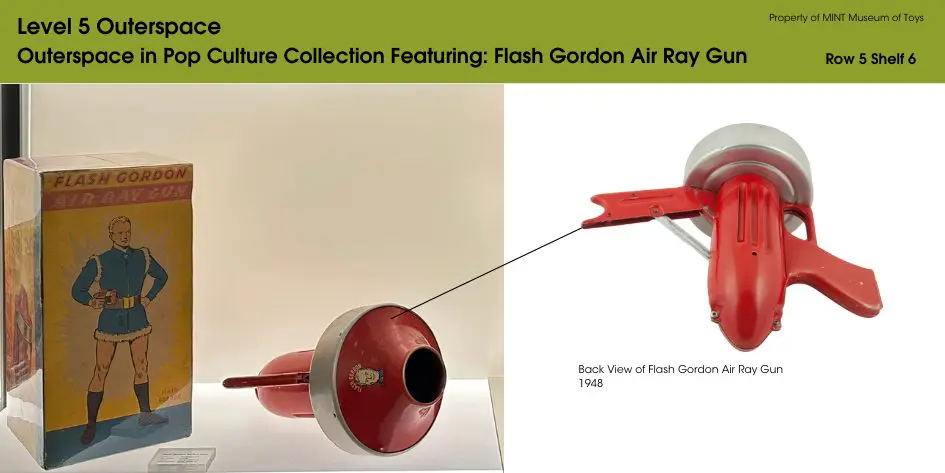
Featured Toy: Flash Gordon Air Ray Gun
Maker: The Budson Co.
Year of Make: 1948
Country of Origin: United States of America
Flash Gordon, the original superhero, predates the rise and dominance of both Marvel and DC, and was even an inspiration to the artists at these two major comic book publishers. It was through his comic strips that we see the first version of the superhero as a modern-day escapist myth: just a normal guy thrown into fantastical circumstances, who ends up saving the world. Comparable to a modern-day Odysseus who encounters multiple adventures while traveling throughout the stars, Flash Gordon represents the idea that anyone can become a hero if they are brave and determined enough.
Tracing Changing Social Mores through Modern-Day Heroes
While ancient mythology is typically more one-sided in its conceptions of good versus evil, modern-day myths via our favourite superheroes and characters allow us to dive deeper into questions surrounding morality, ethics, and humanity. Our favourite characters not only inspire us to become the best versions of ourselves, but provide a way in which we can grapple with changing social mores and question what’s happening around us – whether that’s through seeing Superman as the ultimate saviour, or secretly applauding the ambiguity behind Catwoman’s shady means.
Here at the MINT Museum of Toys, we believe in the power of toys as visual representations of changing social mores, norms, and values. So why not visit our Level 3 Childhood Favourites and Level 5 Outerspace collections and see even more valuable vintage toys and memorabilia of your favourites from the 80’s, 70’s, or even earlier! Whether you’re a fan of DC, Marvel, or classic superheroes, you can definitely appreciate the complexity that modern superheroes bring to the table. Comparing the changes in characters over the decades is also a great way to engage kids in family bonding activities, especially when paired with our UNBOX: Featuring Toy Figurines currently showing at Level 3.
“Space: the final frontier” – Those are the opening lines of every episode in the original Star Trek TV series, and one of the most accurate yet succinct descriptions of humanity’s fascination with outer space.
The cosmos have enchanted us since time immemorial, and in both the real and fictional worlds, space travel has always been seen as one of the ultimate markers of a futuristic, advanced society. Before Laika the dog was launched into orbit or Neil Armstrong took his first step on the moon, there was no shortage of science fiction that imagined what space travel could look like. And even after we finally sent man to the moon, science fiction has continued to imagine new types of spacecrafts that outpace even our latest technological advancements.
Join us as we explore the evolution of spacecrafts real and fictional throughout the 20th century.
1930s: Buck Rogers Battlecruiser
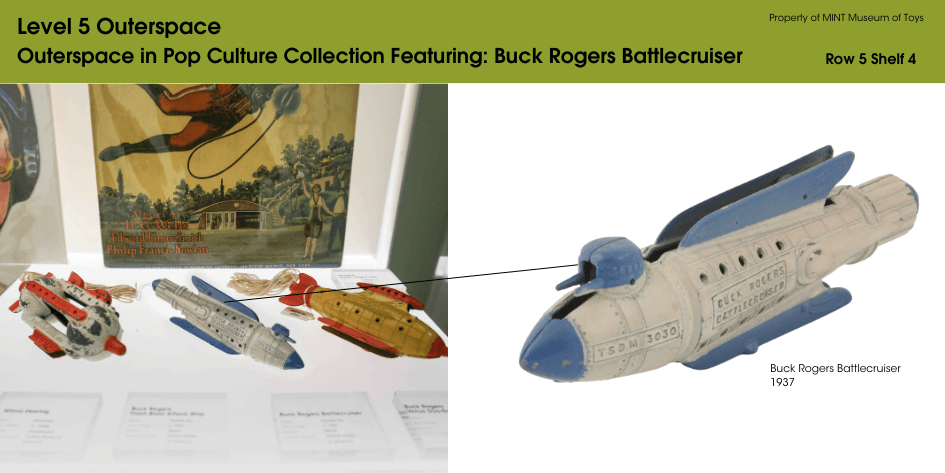
Maker: Tootsie
Year of Make: 1937
Country of Origin: United States of America
In 1928, the world was introduced to Buck Rogers – the world’s first ‘space cowboy’ and the predecessor to more modern sci-fi heroes like Han Solo and Captain Kirk. Rogers first made his debut in a novella by author Philip Francis Nowlan, as a World War I soldier who falls into a state of suspended animation and wakes up hundreds of years later in 2429AD. Rogers’ exploits quickly exploded in popularity, gaining him a syndicated comic, radio series, and several film and TV series in the decades to come. This Buck Roges Battlecruiser reflects the idea of a typical spacecraft at the time, with a plane-like tube body and pointed cone-like nose.
1950s: Dan Dare Space Ship Kit
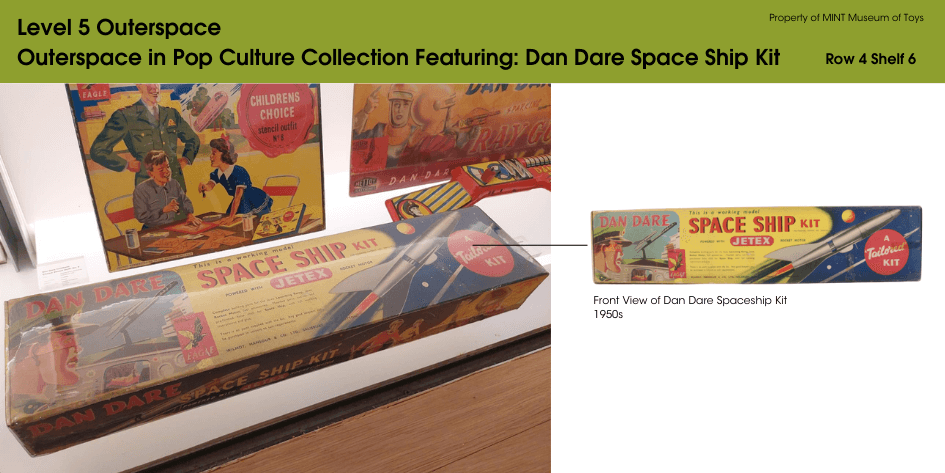
Maker: Wilmot, Mansour & Co
Year of Make: 1950s
Country of Origin: United Kingdom
In the 1950s, Britain gained its own answer to Buck Rogers in the form of comic strip hero Dan Dare. Unlike Rogers’ origins as a ‘normal’ man thrust into an uncertain future, we are introduced to Colonel Daniel McGregor ‘Dan’ Dare as a chief pilot of the Interplanet Space Fleet. This sci-fi setting quickly enthralled readers, resulting in a devoted following that has persisted till today. This Dan Dare Space Ship Kit was just one of the various Dan Dare merchandise sold during the franchise’s heyday, and is still highly sought after by collectors today.
1960s: Space Capsule
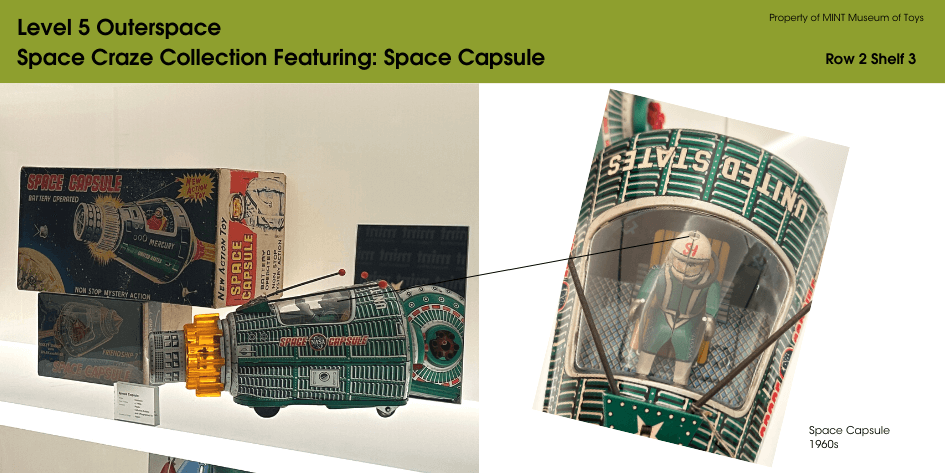
Maker: Horikawa
Year of Make: 1960s
Country of Origin: Japan
The 1960s were a memorable decade for space travel, with events such as the first human spaceflight mission by Yuri Gagarin in 1961 and first successful Mars flyby in 1965. One of the real-life spacecrafts that debuted at this time was the Soyuz, as part of a series manufactured by the Soviet Union in the early 1960s. This Horikawa Space Capsule, though not a direct representation of the Soyuz, draws its visual inspiration directly from the Soyuz’s conic triangular capsule-like design. The toy even fits just one cartoon human pilot within its cockpit, just like the Soyuz.
1960s: Moon Detector
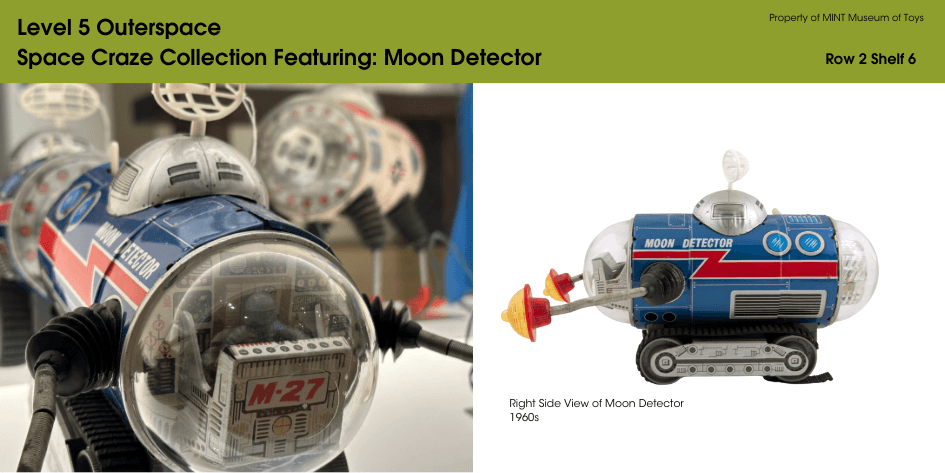
Maker: Yonezawa Toys
Year of Make: 1960s
Country of Origin: Japan
As the earth’s only natural satellite, humankind has always had a fascination with the moon. This Moon Detector from the 1960s imagines the discoveries that could be awaiting on the lunar surface – years before Neil Armstrong, Buzz Aldrin, and Michael Collins would become the first humans to land on the moon in July 1969.
1970s: Millennium Falcon
The Millennium Falcon is arguably the most iconic spacecraft in popular culture. It first appeared in the Star Wars franchise and has become synonymous with the series thanks to the toys and memorabilia released over the years. The Falcon has a distinctive look, with a sleek and futuristic design that is instantly recognisable. It has been featured in numerous films and TV shows, and remains a popular toy and collectible amongst fans and sci-fi enthusiasts alike. While the MINT Museum of Toys does not currently have Star Wars memorabilia on display at the moment, there’s always the possibility we might curate these for a seasonal UNBOX toy exhibition in the future – so stay tuned!
The Future of Space Travel, Today
Beyond the 80s and 90s, the world of spacecrafts (both real and imagined) has continued to expand into the 21st century. From Mars Rovers that gained a widespread following through social media to the Milano of the Marvel Cinematic Universe, spacecraft look and behave completely different from what they looked like a century ago. Our imagination of space travel will also no doubt evolve as we make new advancements in technology, especially with a renewed focus on AI and other intelligent tech.
If you’re a fan of vintage toys (sci-fi or otherwise), be sure to visit the MINT Museum of Toys and explore our Level 5 Outerspace exhibition. There, you can see some of the most popular vintage toys and spacecrafts from between the 1840s to 1980s, including some of the toys mentioned above. You can also browse our blog to discover the behind-the-scenes stories of your favourite childhood toys and characters, including Aesop’s fables and sci-fi pulp magazines.
